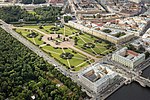Upper Swan Bridge

Upper Swan Bridge (Russian: Верхний Лебяжий мост) is a single-span stone bridge in Saint Petersburg. It is one of the oldest stone bridges in the city and carries Palace Embankment across the Swan Canal. The preceding bridge on the site was of wooden construction, built in the 1710s over the Lebedinka, a shallow watercourse flowing between the Moyka and Neva Rivers, at the point at which it entered the Neva. With the construction of the Swan Canal replacing the Lebedinka, the bridge continued to operate, until being replaced with a stone bridge in 1768. The bridge was alternately known as the Swan Bridge, the Stone Swan Bridge, and finally the Upper Swan Bridge, distinguishing it from the Lower Swan Bridge at the southern end of the canal at its juncture with the Moyka. Structural faults were identified as early as the mid-nineteenth century, but repairs were only carried out in the 1920s. These left the appearance of the bridge unaltered, and it still retains its original form. It has been designated an object of historical and cultural heritage of federal significance.
Excerpt from the Wikipedia article Upper Swan Bridge (License: CC BY-SA 3.0, Authors, Images).Upper Swan Bridge
Kutuzov Embankment, Saint Petersburg
Geographical coordinates (GPS) Address Nearby Places Show on map
Geographical coordinates (GPS)
| Latitude | Longitude |
|---|---|
| N 59.947777777778 ° | E 30.336388888889 ° |
Address
Прачечный мост
Kutuzov Embankment
191187 Saint Petersburg (Литейный округ)
Saint Petersburg, Russia
Open on Google Maps










